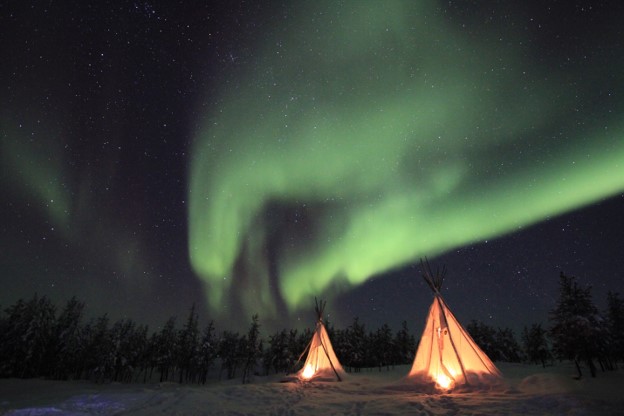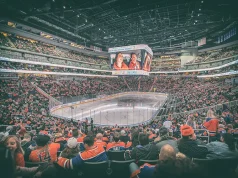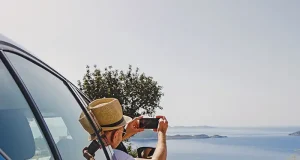
It’s a dream of many travelers to see the ethereal aurora borealis. But where to do it, and how exactly?
Science lesson: First, it’s worth understanding what they are exactly. The northern lights are caused when the sun’s electrically charged particles, buoyed by a solar wind, enter the Earth’s atmosphere and collide with oxygen and nitrogen. The result is a frenzy of dazzling, colorful and mostly silent activity that’s particularly visible near the magnetic pole. The lights are known for their frenetic movement, moving surprisingly quickly in all directions (or “dancing”) across the inky night sky.
Where and when: The places to be are Yukon, Northwest Territory, and Nunavut, as much of the area is situated under the Auroral Oval and light pollution is minimal. Winter is prime viewing time, as there are more hours of darkness and cold, clear nights offering an enticing backdrop for the lights to make their appearance. Working in partnership with the Canadian Space Agency and the nonprofit Astronomy North puts out an updated aurora forecast.
The whole picture: Many Indigenous groups live in Canada’s northern reaches and each has its own beliefs and legends to explain the phenomenon. Exploring these is an important part of a northern lights viewing experience. On an aurora tour with B. Dene Adventures in Yellowknife, guests hear legends and stories straight from the elders as they listen to traditional drumming and dine on fish cooked over a fire.
Across the North:
Perhaps the best place in the world to see the lights is the Northwest Territories, where they’re generally visible 240 nights per year. Here, Blachford Lake Lodge and Wilderness Resort and Aurora Village in Yellowknife are top spots for viewing.
Churchill, Manitoba, is billed as one of the top three places on the planet to see the lights, with scientists from around the world flocking there to study the mysterious auroras. Tour operator Frontiers North offers midnight aurora viewing in heated Tundra Buggies kitted out with bars.
Nunavut is also a prime aurora viewing country, with October to April the best time to catch the show. Visit Whale Cove to fish and spot beluga whales after a night of aurora viewing,
In Newfoundland and Labrador, swathes of untouched wilderness beckon visitors seeking remote outdoor adventure under a sky filled with majestic Northern Lights. Torngat Mountains National Park offers the perfect setting to see the show, with dramatic geology, four billion-year-old rock formations and the traditional Inuit way of life providing a memorable backdrop to the lights.
And in northern Alberta, you’ll find the Geophysical Observatory at Athabasca University, which studies the aurora’s magnetic impact on Earth. To see the science in action, head to Banff National Park checking the university’s Aurora Watch beforehand to plan your trip when chances of seeing the lights are high.
Spotlight: A Yukon Northern Lights Itinerary
The Yukon’s vast landscape is rife with opportunities to see the auroral borealis – from land and sky. Here, the lights are visible between September and April, though they are particularly active during the first few weeks of winter.
Day 1: Start your journey by flying into Whitehorse, the territory’s capital city, a sprawling wilderness of ice fields, frozen forests and the tallest mountain peak in Canada.
- Check into the Raven Inn, Whitehorse’s first new hotel in nearly half a century. Here, modern hospitality trends pay homage to the historical and natural legacy of the Yukon. You’ll stay overnight in comfort with plenty of diversions, including a rail-themed bar serving Yukon-crafted beer and cider, and an outdoor heated pool overlooking the Yukon River.
- Start your northern lights experience by chasing the show straight out of the gate. Who What Where Tours’ Aurora/Northern Lights expedition whisks guests away from the city lights, to a cozy fire – complete with blankets, chairs and hot drinks – to wait for the lights to make their dazzling appearance.
Day 2: The next morning, enjoy an invigorating start to the day – and experience an ages-old Yukon tradition – with a half-day dog sledding excursion, provided by Muktuk Adventures. Guests will learn how to “mush” while passing through a winter wonderland backdropping river or forest trails.
- Fuel up at Gather Café and Taphouse, a cozy community eatery close to the Raven Inn that features locally sourced fare and exquisite cocktails.
- In the evening, board Tintina Air for a magical Northern Lights Flight, where you’ll drift among the clouds as the sky explodes with color around you. The one-hour flight includes hot chocolate and a snack, so you can keep away the chill during this once-in-a-lifetime adventure.
Day 3: The next morning, drive two hours to Kluane National Park. Check into Mount Logan Eco Lodge, an all-inclusive property that offers gourmet meals, a hot tub and sauna, firepit and guided day tours into the surrounding wilderness. Accommodation options are plentiful: guests can stay in a prospector tent, intimate pod, cabin or even a gypsy school bus.
- Don’t miss the lodge’s Northern Lights photography tour. The guide will share tips, tricks and best practices for capturing the auroras on camera.
Day 4: The next day, see Kluane National Park – including Mount Logan, the tallest summit in Canada – on a glacier flightseeing tour with Rocking Star Adventures.
- Spend the rest of the day snowmobiling, snowshoeing or electric fat biking through the Yukon’s snowy landscapes. This might be the end of your journey, but after the legendary experience you’ve had, we suspect you’ll return soon.





